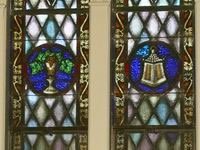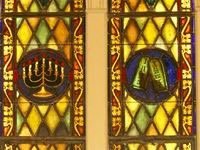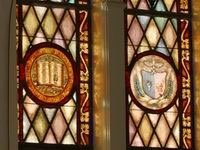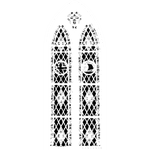“Why These Windows Matter”
by Sarah Roberson Yates
What follows was originally written as a talk that I was invited to give to the congregation of the Salem Presbyterian Church shortly before the church windows were renovated. As I said that day, saving the windows was going to take serious work and a significant investment of resources. Fortunately, the congregation has taken seriously its stewardship of these beautiful windows, and the ancient messages that are still fresh today.
I have not rewritten this talk, except for changing the introduction and a few minor details. My talk in the sanctuary of the church in which I grew up was deeply personal, and I decided to keep that feeling, rather than turn this into one that’s more academic.
MOTHER’S TALK
I know that my mother gave a talk on these windows several years ago. When I was preparing what I’d say, Julia Dyer asked me if I was going to give the same speech – I know a lot of you probably remember her talk.
Unfortunately, I haven’t been able to find her paper. I’m quite certain she talked with great feeling about the church in the era when these windows were purchased, and the folks who donated them, because she was active in the church back then and she knew everyone whose name appears on one of the plaques.
But I don’t – and with a few exceptions – neither do many of you.
A DIFFERENT RELATIONSHIP
Today, we’re called to have a different relationship with these windows. In my opinion, they are the most beautiful church windows in Salem, certainly, but they’re also among the most beautiful I’ve ever seen.
CHURCHES IN NEW ENGLAND
If you’ve been to churches in New England, you probably realized that many churches there have clear windows. Now, the colonists imported a great many products from England and Europe, and some outstanding artisans were among the early settlers, so those clear windows were a choice our ancestors made.
That’s because those ever-cheerful Puritans distrusted rich adornments. And colored windows were adornments.
THE PROCESS OF MAKING GLASS
We know that the Egyptians had figured out how to make glass by about 400 B.C. We don’t have a clue how they figured out that if you mixed sand in the right proportions with alkali and then applied heat, you’d end up with glass. At first, the process was regarded as a mystery, and it was a secret known only to a very select band of craftsmen.
THE PROCESS OF MAKING STAINED GLASS WINDOWS
By the 10th century AD, artisans had figured out how to create whole windows constructed from a mosaic of colored glass. We know that because a Catholic monk named Theophilus recorded detailed instructions on how to construct a stained glass window using pieces of colored glass with lead supports, or “came.” The process he described has changed little over time.
As church architecture got bigger, glass artisans began making more elaborate windows. You can see the highest form of the art in European cathedrals that were built in the Middle Ages.
OUR WINDOWS
In one sense, I guess our windows are no match for those fabulously intricate stained glass windows from a cathedral. But in a very real sense – they suit us better.
HISTORICAL PERSPECTIVES – PRESBYTERIANS IN SALEM
Before I really start talking about the windows – just a little historical perspective about Presbyterians in Salem. The first congregation formed in 1816 – that’s also the year Indiana became the 19th state to enter the Union – just 10 years after Merriweather Lewis and William Clark returned from their momentous journey to map the great and unknown lands of north west territory.
In that time, Indiana was at the edge of the western frontier. It was, quite literally, the West.
The building we’re in today wasn’t the first meeting place for Presbyterians in Salem – when the congregation first formed, they met in the court house – and when the congregation built its first church, that was located on the East side of High Street at what was then the extreme North end of the town, probably no more than a couple of blocks from here.
The congregation apparently didn’t like the commute, so they elected to move closer to the square – and that’s where this building comes in.
WORK ON THIS BUILDING
Work on this building was begun in 1839 – so, what was happening in America then? The nation didn’t even have its Northern and Southern borders defined; yet we were on an inexorable march toward Civil War because the issue of slavery was slicing deeper divisions between North and South. The nation’s first spontaneous liberation movement – the Underground Railroad – was aiding escaping slaves from the American South reach freedom in Canada, and Presbyterians throughout southern Indiana played pivotal roles in that movement. Martin Van Buren was President, and the nation was in the grip of a deep economic Depression. So building this church was an act of faith right from the beginning.
NOW FOR THE WINDOWS
Those tell you something about the times, so let’s turn now to the windows. First stop – their architecture.
The style of window is called a Gothic arch – the Gothic Revival was a movement in American architecture that ran from about 1840 – 1880 – and it mimicked the style of building you find in Europe that was built in the Medieval period – in other words, the period of the great cathedrals.
The Gothic Revival movement was really big in “rural” areas, in part because one of its first proponents wrote a book detailing its use in rural settings.
NOT ORIGINAL WINDOWS – BUT SHAPE IS
Even though these aren’t the original windows, their shape is. These windows were installed in August 1956. At that time, the church members had very protracted discussions about what to do with the church building, which at that time was over 100 years old. Eventually, they decided to put more money into renovating the building, rather than starting over. New windows were part of that general “face-lift.”
SYMBOLICALLY POINT US TO GOD
Symbolically – these windows point us to God – they lead the eye upward – and point straight to the heavens.

We tend to think of the medallions as the important part of the window – but every aspect of these windows conveys a meaning. There’s nothing accidental.
EACH WINDOW THE SAME
Each separate window is the same. Two long lateral panels, topped by a diamond shaped crest. – and if you break down the structure further, each lateral panel is the same – two bottom panels, the medallion panel, topped by an arch.
To Christians, the number three is the most powerful number, because it symbolizes the Trinity. And each of these windows is loaded with 3s.
Each bottom panel contains of six rows – that’s 2 3s -- of three diamonds. And you get a diamond when you put the bases of two equilateral triangles together.
Also – see these ivy scrolls? Three leaves. Ivy also stands for faithfulness and memory. And many of these windows were given to the church in memory of someone who had died.
Also, there’s a repeated motif of a cross formed by these stylized leaves – 4 leaves also represent the 4 evangelists – Matthew, Mark, Luke and John -- and each window is topped by the center diamond cross that is a larger rendering of the smaller ones.
Now, for the windows themselves – Let’s start back in Carolyn Haag’s corner (the North East corner).
1. Cross with I.N.R.I. banner

The banner on the cross has the initial letters for the Latin inscription on the cross – Jesus Nazarenus Rex Iudaeorum. Jesus of Nazereth, King of the Jews. You’ve no doubt seen this in a lot of churches and books, gift shops, because it is one of the most recognizable symbols of Christianity.
The bunch of Easter lilies - The lily is a flower associated with Jesus’ resurrection. If you’re a gardener, you know you plant the bulb, it decays, staying in the ground over winter, and in the spring, comes back to new life.
These windows were given by the Mariners, which was an adult fellowship group that was very active during the 1950s, 1960s, and 70s.
2. Chalice with grapes

Of course, the chalice with the grapes is a representation of the blood of Christ and the sacrament of Holy Communion.
Censer - I’ve got to confess, I’m pretty well stumped by this one. I always thought it was a lantern. And that one’s easy – a light shining in the darkness – one of the most universal symbols of Jesus.
But I don’t really think it’s a lantern – Then Sara and I talked about the possibility it was a censer – a container that holds burning incense – these are commonly used in Catholic services – and you’ve probably seen a priest holding a censer on a chain and swinging it – so that the incense clouds the air.
See that little puff of white back there?
Censers have been used since the ancient temples, when a piece of a burnt offering was placed inside – and if you remember stories from Exodus, you might recall there are several references to the stiff-necked children of God offering up burnt offerings that smelled sweet to God.
But when I showed a picture of this window to the priest at the church where I work, she said it wasn’t a censer – she suggested it might be a tabernacle – that’s a small chest that carried the Torah. If you remember from the Exodus story, the Children of Israel carried the tabernacle and God’s being surrounded it – a spirit cloud by day and a fire by night.
I’m afraid I’m going to have to leave you in uncertainty!
The windows were given to the church in memory of Margaret Bare McClellan and Edith McClellan Wiggs by the Louie DeJean family
3. Menorah

The Menorah is the 7-branched candle holder from the temple. Today, it’s a well-known symbol of the Jewish faith – tho this isn’t the same menorah that’s used at Channauka – that one has 9 candles.
This is the traditional shape of the candle holder from the Temple in Jerusalem. When Christians use this symbol, the 7 branches represent the Holy Spirit and the 7 gifts: wisdom, understanding, counsel, might, knowledge, fear of the Lord and delight in the Lord.
The 2 tablets of Moses - It’s fitting that in the next panel, we have the two tablets, or the 10 Commandments, that Moses received on Mt. Sinai. Together, these two make a strong statement about our Old Testament foundation.
The windows were given in memory of Mr. and Mrs. John F. Alexander by Laura Alexander
John Alexander had a hardware and china store on the southwest corner of West Market and North Water streets. In my mother’s scant notes that I found in the church files – she notes that she doesn’t recall hearing much about John Alexander’s participation in the church, but Mrs. Alexander was active in the church’s missionary society. Laura was their daughter – who was unmarried – and worked in the store.
4. 6-pointed star

The 6-pointed star is the Star of David, another symbol of our shared heritage with Jews – but drawn this way, the star is what’s known as the “Creation” Star. It took God 6 days to create the world.
The Right Hand of God in cloud - Notice – 3 fingers extended downward. Another 3. That’s the right hand of God extending from a cloud –the fingers in this position represent a blessing, or benediction.
These windows are for The Rev. Mr. George W. and Mrs. Martha E. Telle given by Louise Telle Martin.
Rev. Telle was the principal at the high school and Mother recalled hearing about him – Louise taught elementary school – she played the old pump organ that used to sit in the choir loft.
Okay – now we move to the other side.
5. Crown w/ cross and cross

The crown with the cross is also another enduring symbol of the Christian faith and represents the “Kingdom of the Lord,” and Jesus’ role as spiritual king. Note the clusters of three on each end of the cross – and the three spikes of the crown. More 3s.
Ford A. Smith and Blanche F. Smith given by Lee E. Smith
Ford Smith was the founder of Smith Cabinet – and his wife Blanche was very active in the church and a major benefactor. She was the sister of Mrs. John Alexander – back there. Lee was their son – he was married to Eleanor Smith and was the father of Terrilee Suvak and Kim, whom some of you probably know.
6. Noah's dove

The reason I know this is Noah’s dove is that we see the bird from the side carrying a green sprig in its mouth. When the dove is flying downward – as it is in the next panel, that’s a symbol for the Holy Spirit. Like the rainbow, Noah’s dove symbolizes God’s covenant with his people.
Boat with cross mast - You’ll see a lot of different styles in boats and masts in Christian symbols – and the image is one of the oldest in Christendom – the two most predominant images in the catacombs of Rome are boats and fishes –
Traditionally, the boat represents the Church – and recalls stories of Noah’s ark, Moses’ rescue from the bulrushes, and Jesus and the disciples, fishing on the Sea of Galilee --
Ella Frances McClintock given by Arthur C. McClintock
Ella McClintock was the mother to Arthur, who gave this window – She was very active in the Missionary Society, and Arthur was one of the strongest financial supporters of the church, especially during the years of the Great Depression, when times were very hard around here.
7. A scroll?

This book or scroll represents the word of God, and the inscription Lux, Lucet in, Tenebris means “the light shines in darkness.”
Presbyterian shield - This is the shield of the General Assembly that was re-envisioned by Malcolm Grear, one of the nation’s outstanding graphic designers into this – [Show new shield] The new shield conveys virtually the same images in a more stylized way.
One of the things that’s interesting about these two panels is that they’re artistically quite different from the other medallions. They have more of the feeling of an English baronial hall than the others which tend to be stylized images.
James F. and Araminta Lockwood Persise, Miss Ellen Lockwood given by Ellen Persise Stout
James F. and Araminta Lockwood Persise were my great grandparents – and Ellen Lockwood was Araminta’s sister. Ellen Persise Stout, who gave the window, was their daughter – my great aunt. She grew up in this church, but moved away to Louisville after she got married.
8. Open Bible

The open Bible is a very familiar symbol in Christian churches – it symbolizes the accessibility of the word of God to all.
Candle - A candle, of course, is another symbol for the light of God’s word illuminating the dark places.
Mr. and Mrs. Reed Boggs. I imagine a number of you remember Reed and Carrie Boggs – Reed owned a men’s clothing store where the antique mall is on the square today. They were cornerstones of this church, and active in it throughout the years. As a side-note – Carrie and my mother were close friends – they also played in a bridge four-some that included Barb Helsel and Agnes Lundberg – but mother and Carrie didn’t necessarily see eye-to-eye on all issues. In fact, they had some rather vigorous disagreements, among which had to do with womens’ roles in the church. My mother was the first ruling elder ordained in the church – and Carrie Boggs absolutely did not approve of women serving as elders.
9. Building on a rock

Lee L. Persise and Ellen Persise Stout given by Ellen Persise Stout. This window was dedicated to my grandparents by my aunt.
The building on the rock is often seen as a symbol for the church – In the 6th chapter of Matthew, we learn that the apostle Peter was designated by Jesus as “the rock upon which I will build my church.”
The band that circles the medallion reads “A mighty fortress is our God.” Except – the word fortress is misspelled – I actually had to ask Sara where the window with the misspelled word was – you’d think I’d have seen it before now – but I never was much of a proofreader.
Burning bush - And finally, of course, the burning bush, one of the ways in which God appeared to Moses.
Windows of colored glass in a cathedral or church have always been an expression faith. The windows that surround us today are, quite literally, the Faith of Our Fathers. These symbols are expressions of what mattered to the people of the Salem Presbyterian Church in the 1950s when they replaced the church’s original windows, and the symbols still resonate today as the foundation principles that guide Christian worship.
In the coming months, as you work as a individuals and a congregation to save these windows, keep in mind that you’re not merely saving some pretty pieces of colored glass. You’re making a statement about your own faith, about what matters to you today, and what legacy you’ll be leaving for the future.
The renovation of the church windows was begun in September, 2004 and completed in December.
# # #


